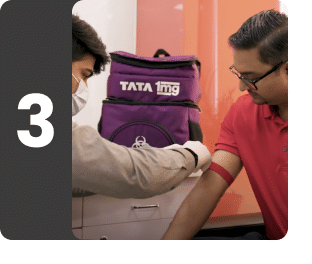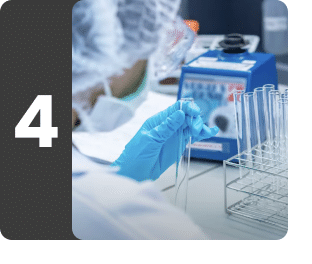Post COVID Health Checkup in New Delhi
Understanding Post COVID Health Checkup in New Delhi
What is Post COVID Health Checkup in New Delhi?
The infection of Coronavirus can have certain long term effects on health. It is suggested to go for some medical tests that helps in monitoring the overall health status of the patient who has recently recovered from the infection of Coronavirus. Post-COVID Health Checkup is a group of tests that include all relevant tests that help you keep a track of your health after you have suffered a COVID-19 infection. The tests screen the condition of heart, liver, kidney through the detection of specific markers. This package also detects antibodies developed post-COVID and the presence of any bacterial or fungal infection that can develop as a complication of COVID. The package helps you stay alert after the infection to determine whether or not you require medical attention.
What does Post COVID Health Checkup measure?
Contains 44 testsLactate Dehyderogenase, Serum

CRP (C-Reactive Protein) - Quantitative
A CRP test measures the levels of C-reactive protein in your body. This test helps detect the presence of inflammation in the body. It is a non-specific test as it cannot diagnose a condition by itself or determine its exact location or cause.
CRP is an acute phase reactant protein produced by the liver in response to an inflammation in the body. This inflammation may be due to tissue injury, infection, autoimmune diseases, or cancer. CRP levels are often increased before the onset of other symptoms of inflammation, such as pain, redness, fever, or swelling. These levels fall as the inflammation subsides.
Know more about CRP (C-Reactive Protein) - Quantitative

Creatine Kinase
Creatine kinase is a type of enzyme found in muscles, especially in heart muscles. It is of three types: CK-MM (found mostly in your skeletal muscles), CK-MB (found mostly in your heart muscle), and CK-BB (found mostly in your brain tissue).
CK levels typically rise sharply within 3 to 5 hours after a heart attack, reach a maximum level after 12-14 hours, and return to normal range after 3-4 days after a heart attack. Doctors often repeat this test to check the CK levels after some time.
Know more about Creatine Kinase

TSH (Thyroid Stimulating Hormone) Ultrasensitive
A TSH (Thyroid Stimulating Hormone) Ultrasensitive test measures the levels of TSH hormone in the blood. TSH is produced by the pituitary gland located in the brain. Its function is to stimulate and regulate the functioning of the thyroid gland. It signals the thyroid gland to increase or decrease the production of thyroid hormones T3 and T4 (essential for regulating our body’s metabolism, temperature, heart rate, and growth) when their levels are low or high, respectively. Therefore, when the levels of T3 & T4 decrease, the pituitary gland is stimulated to release TSH. This high TSH level, in turn, stimulates the thyroid gland to release more thyroid hormones (T3 & T4); the vice-versa happens when the levels of thyroid hormones increase.
Know more about TSH (Thyroid Stimulating Hormone) Ultrasensitive

LFT (Liver Function Test)
An LFT (Liver Function Test) helps determine the health of your liver by measuring various components like enzymes, proteins, and bilirubin. These components help detect inflammation, infection, diseases, etc., of the liver and monitor the damage due to liver-related issues.
Know more about LFT (Liver Function Test)
Bilirubin Indirect
A Bilirubin Indirect test measures the amount of indirect or unconjugated bilirubin in your body. Bilirubin is a yellowish byproduct primarily produced when your body breaks down aged red blood cells (RBCs). When RBCs finish their lifespan of 120 days, they break down and pass to your liver. Indirect bilirubin, a form of bilirubin that is unconjugated (not soluble in water), is bound to the protein albumin that helps transport it to the liver. When the liver processes the bilirubin, it unbinds from the albumin and binds to a sugar molecule, making it water-soluble. This water-soluble bilirubin is mixed with bile, excreted in the bile ducts, and stored in your gallbladder. Finally, bile is released into the small intestine to help digest fat and is eventually excreted with your stool as a waste product.
Bilirubin Direct
A Bilirubin Direct test measures the amount of direct or conjugated bilirubin present in your body. Bilirubin is a yellowish byproduct primarily produced when the body breaks down aged RBCs. When the RBCs finish their lifespan of 120 days, they break down and pass to the liver. In the liver, direct bilirubin–a form of bilirubin conjugated with glucuronic acid (sugar)–is processed, mixed with bile, and then excreted in the bile ducts and stored in your gallbladder. Finally, the bile is released into the small intestine where it is further broken down and helps digest fat. It is eventually excreted within your stool as a waste product.
Elevated levels of bilirubin can be indicative of various liver or bile duct issues. Additionally, higher bilirubin levels might result from an increased breakdown of red blood cells in the body.
Gamma Glutamyl Transferase
Gamma-Glutamyl Transferase (GGT) is an enzyme found in various organs, with the highest concentration in the liver. Usually, this enzyme is present in low levels in the blood. However, when there is liver damage or disease, GGT is released into the bloodstream, causing an increase in GGT levels. In addition to the liver, GGT can also be elevated in conditions affecting the bile ducts or the pancreas. It is usually, the first liver enzyme to rise in the blood when there is any damage or obstruction in the bile duct, making it one of the most sensitive liver enzyme tests for detecting bile duct problems.
Bilirubin Total
A Bilirubin Total examination quantifies the levels of total bilirubin in the body, encompassing both indirect (unconjugated) and direct (conjugated) bilirubin. Bilirubin, a yellowish waste substance, is primarily generated during the breakdown of aging red blood cells (RBCs) in the body. After their typical lifespan of 120 days, RBCs disintegrate in the liver, leading to the production of a substantial amount of bilirubin. It is crucial for this bilirubin to be eliminated from the body.
SGPT
An SGPT test measures the amount of ALT or SGPT enzyme in your blood. ALT is most abundantly found in the liver, but it is also present in smaller amounts in other organs like the kidneys, heart, and muscles. Its primary function is to convert food into energy. It also speeds up chemical reactions in the body. These chemical reactions include the production of bile and substances that help your blood clot, break down food and toxins, and fight off an infection.
Elevated levels of ALT in the blood may indicate liver damage or injury. When the liver cells are damaged, they release ALT into the bloodstream, causing an increase in ALT levels. Therefore, the SGPT/ALT test is primarily used to assess the health of the liver and to detect liver-related problems such as hepatitis, fatty liver disease, cirrhosis, or other liver disorders.
Alkaline Phosphatase (ALP)
An Alkaline Phosphatase (ALP) test measures the quantity of ALP enzyme present throughout the body. The main sources of this enzyme are the liver and bones. It exists in different forms depending on where it originates, such as liver ALP, bone ALP, and intestinal ALP. In the liver, it is found on the edges of the cells that join together to form bile ducts.
ALP levels can be increased during pregnancy as it is found in the placenta of pregnant women. It is also higher in children because their bones are in the growth phase. ALP is often high during growth spurts (a short period when an individual experiences quick physical growth in height and body weight).
SGOT
An SGOT test measures the levels of serum glutamic-oxaloacetic transaminase (SGOT), also known as aspartate aminotransferase (AST), an enzyme produced by the liver. SGOT is present in most body cells, most abundantly in the liver and heart. The primary function of this enzyme is to convert food into glycogen (a form of glucose), which is stored in the cells, primarily the liver. The body uses this glycogen to generate energy for various body functions.
Protein Total, Serum
- Serum Albumin
- Protein Total
- Globulin, Serum
- Albumin/Globulin Ratio, Serum
A Protein Total, Serum test measures the amount of proteins in the body. Proteins are known as the building blocks of all cells and tissues. They play a crucial role in the growth and development of most of your organs and in making enzymes and hormones. There are two types of proteins found in the body, namely albumin and globulin. About 60% of the total protein is made up of albumin, which is produced by the liver. It helps to carry small molecules such as hormones, minerals, and medicines throughout the body. It also serves as a source of amino acids for tissue metabolism. On the other hand, globulin is a group of proteins that are made by the liver and the immune system. They play an important role in liver functioning, blood clotting, and fighting off infections.
This further contains

KFT with Electrolytes (Kidney Function Test with Electrolytes)
A KFT with Electrolytes (Kidney Function Test with Electrolytes) test determines the health of your kidneys. It evaluates parameters such as creatinine, blood urea nitrogen (BUN), uric acid, and electrolytes (sodium, potassium, and chloride). This test also helps diagnose possible kidney disorders like inflammation, infection, or functional damage.
Know more about KFT with Electrolytes (Kidney Function Test with Electrolytes)
Serum Creatinine
A Serum Creatinine test measures the level of creatinine in the blood. Creatinine is a byproduct of muscles’ wear and tear during energy production. The kidneys remove it from the body by filtering it from the blood and releasing it into the urine. Therefore, blood creatinine levels indicate how well the kidneys are functioning in filtering and removing waste products from the blood. Generally, higher creatinine levels in the blood may indicate reduced kidney function, while lower levels may suggest decreased muscle mass.
Potassium
A Potassium test measures the levels of potassium in your body. Potassium is one of the key electrolytes that helps in the functioning of the kidneys, heart, nerves, and muscles. It also balances the effect of sodium and helps keep your blood pressure normal. The body absorbs the required amount of potassium from the dietary sources and eliminates the remaining quantity through urine. Potassium level is typically maintained by the hormone aldosterone. Aldosterone acts on the nephrons present in the kidneys and activates the sodium-potassium pump that helps the body reabsorb sodium and excrete potassium. This aids in maintaining a regular and steady potassium level in the blood.
Uric Acid
A Uric Acid test determines the level of uric acid in your body. Uric acid is a nitrogenous compound produced by the metabolic breakdown of purine. Purines are present as nitrogenous bases in the DNA and are also found in food like red meat and seafood.
Most uric acid dissolves in the blood and goes into your kidneys. From there, it passes through your body via the urine. Decreased elimination of uric acid is often a result of impaired kidney function due to kidney disease. In many cases, the exact cause of excess uric acid is unknown. Doctors seldom need to test for low levels of uric acid.
Chloride
A Chloride test measures the amount of chloride in your body. Chloride is present in all body fluids and is found in the highest concentration in the blood and extracellular fluid (fluid present outside the cells). The body gets most of the chloride through dietary salt (sodium chloride or NaCl) and a small amount through other food items. The required amount of chloride is absorbed in the body and the excess amount is excreted by the kidneys through urine. When the chloride is combined with sodium it is mostly found in nature as salt. Chloride generally increases or decreases in direct relationship to sodium but may also change without any changes in sodium levels when there are problems with the body's pH. Usually, the normal blood chloride level remains steady with a slight fall after meals (because the stomach produces hydrochloric acid using chloride from the blood after we eat food).
Sodium
-
By producing hormones that control the elimination of sodium through urine, such as natriuretic peptides and aldosterone.
-
By producing hormones that prevent water loss, such as antidiuretic hormone (ADH) or vasopressin.
-
By controlling thirst (an increase in blood sodium level can make you thirsty and cause you to drink water, returning your sodium to normal).
A Sodium test is used to measure the amount of sodium in your body. Sodium is present in all body fluids and is found in the highest concentration in the extracellular fluid. The body absorbs the required amount of sodium through dietary salts and the remaining is eliminated through the kidneys. The body keeps your blood sodium within a normal and steady range by following three mechanisms:
These mechanisms regulate the amount of water and sodium in the body and control blood pressure by keeping the amount of water in check. When the level of sodium in the blood changes, the water content in your body changes. These changes can be associated with dehydration, edema, and change in blood pressure.
Blood Urea Nitrogen (BUN)
A Blood Urea Nitrogen (BUN) test measures the levels of urea nitrogen in the blood. Blood urea is a waste product that is formed in the liver when you eat food and the protein is metabolized into amino acids. This process leads to the production of ammonia that is further converted into urea. Both ammonia and urea are nitrogenous compounds. Your liver releases urea into the blood which is then carried out to the kidneys. In the kidneys, urea is filtered from the blood and flushed out of the body via urine. This is a continuous process, so a small amount of urea nitrogen always remains in the blood.
In the case of a kidney or liver disease, there is a change in the amount of urea present in the blood. If your liver produces urea in an increased amount or if there is any problem in kidney functioning, there might be difficulty in filtering out the waste products from the blood, which can result in increased urea levels in the blood.

Complete Blood Count With NLR
Differential Leukocyte Count
- Differential Neutrophil Count
- Differential Lymphocyte Count
- Differential Monocyte Count
- Differential Eosinophil Count
- Differential Basophil Count
There are five types of WBCs: neutrophils, lymphocytes, monocytes, eosinophils, and basophils. A Differential Leukocyte Count test measures the percentage of each type of WBC in the blood. Leukocytes or WBCs are produced in the bone marrow and defend the body against infections and diseases. Each type of WBC plays a unique role to protect against infections and is present in different numbers.
This further contains
Red Blood Cell Count
A Red Blood Cell Count test measures the total number of red blood cells in your blood. RBCs are the most abundant cells in the blood with an average lifespan of 120 days. These cells are produced in the bone marrow and destroyed in the spleen or liver. Their primary function is to help carry oxygen from the lungs to different body parts. The normal range of RBC count can vary depending on age, gender, and the equipment and methods used for testing.
Hb (Hemoglobin)
An Hb (Hemoglobin) test measures the concentration of hemoglobin protein in your blood. Hemoglobin is made up of iron and globulin proteins. It is an essential part of RBCs and is critical for oxygen transfer from the lungs to all body tissues. Most blood cells, including RBCs, are produced regularly in your bone marrow. The Hb test is a fundamental part of a complete blood count (CBC) and is used to monitor blood health, diagnose various blood disorders, and assess your response to treatments if needed.
Platelet Count
A Platelet Count test measures the average number of platelets in the blood. Platelets are disk-shaped tiny cells originating from large cells known as megakaryocytes, which are found in the bone marrow. After the platelets are formed, they are released into the blood circulation. Their average life span is 7-10 days.
Platelets help stop the bleeding, whenever there is an injury or trauma to a tissue or blood vessel, by adhering and accumulating at the injury site and releasing chemical compounds that stimulate the gathering of more platelets. A loose platelet plug is formed at the site of injury and this process is known as primary hemostasis. These activated platelets support the coagulation pathway that involves a series of steps, including the sequential activation of clotting factors; this process is known as secondary hemostasis. After this step, there is a formation of fibrin strands that form a mesh incorporated into and around the platelet plug. This mesh strengthens and stabilizes the blood clot so that it remains in place until the injury heals. After healing, other factors come into play and break the clot down so that it gets removed. In case the platelets are not sufficient in number or not functioning properly, a stable clot might not form. These unstable clots can result in an increased risk of excessive bleeding.
Total Leukocyte Count
A Total Leukocyte Count test measures the numbers of all types of leukocytes, namely neutrophil, lymphocyte, monocyte, eosinophil, and basophil, in your blood. Leukocytes or WBCs are an essential part of our immune system. These cells are produced in the bone marrow and defend the body against infections and diseases. Each type of WBC plays a unique role to protect against infections and is present in different numbers.
Hematocrit
A Hematocrit test measures the proportion of red blood cells (RBCs) in your blood as a percentage of the total blood volume. It is a crucial part of a complete blood count (CBC) and helps in assessing your blood health. RBCs are responsible for carrying oxygen from the lungs to different parts of the body. The hematocrit test provides valuable information about your blood's oxygen-carrying capacity.
Higher-than-normal amounts of RBCs produced by the bone marrow can cause the hematocrit to increase, leading to increased blood density and slow blood flow. On the other hand, lower-than-normal hematocrit can be caused by low production of RBCs, reduced lifespan of RBCs in circulation, or excessive bleeding, leading to a reduced amount of oxygen being transported by RBCs. Monitoring your hematocrit levels is essential for diagnosing and managing various blood-related disorders.
Mean Corpuscular Volume
A Mean Corpuscular Volume test measures the average size of your red blood cells, which carry oxygen through your body. This test tells whether your RBCs are of average size and volume or whether they are bigger or smaller.
Mean Corpuscular Hemoglobin
An MCH test measures the average amount of hemoglobin in a single red blood cell (RBC). Hemoglobin is an iron-containing protein in RBCs, and its major function is to transport oxygen from the lungs to all body parts. This test provides information about how much oxygen is being delivered to the body by a certain number of RBCs.
Mean Corpuscular Hemoglobin Concentration
An MCHC test measures the average amount of hemoglobin in a given volume of RBCs. MCHC is calculated by dividing the amount of hemoglobin by hematocrit (volume of blood made up of RBCs) and then multiplying it by 100.
Absolute Leucocyte Count
- Absolute Lymphocyte Count
- Absolute Neutrophil Count
- Absolute Basophil Count
- Absolute Monocyte Count
- Absolute Eosinophil Count
This further contains
Mean Platelet Volume
An MPV test measures the average size of the platelets in your blood. Platelets are disk-shaped tiny cells originating from large cells known as megakaryocytes, which are found in the bone marrow. After the platelets are formed, they are released into the blood circulation. Their average life span is 7-10 days.
Platelets help stop bleeding whenever there is an injury or trauma to a tissue or blood vessel by adhering and accumulating at the injury site, and by releasing chemical compounds that stimulate the gathering of more platelets. After these steps, a loose platelet plug is formed at the site of injury, and this process is known as primary hemostasis. These activated platelets support the coagulation pathway that involves a series of steps including the sequential activation of clotting factors; this process is known as secondary hemostasis. After this, there is a formation of fibrin strands that form a mesh incorporated into and around the platelet plug. This mesh strengthens and stabilizes the blood clot so that it remains in place until the injury heals. After healing, other factors come into play and break the clot down so that it gets removed. In case the platelets are not sufficient in number or are not functioning properly, a stable clot might not form. These unstable clots can result in an increased risk of excessive bleeding.
PDW
A PDW test reflects variability in platelet size, and is considered a marker of platelet function and activation (clot formation in case of an injury). This marker can give you additional information about your platelets and the cause of a high or low platelet count. Larger platelets are usually younger platelets that have been recently released from the bone marrow, while smaller platelets may be older and have been in circulation for a few days. Higher PDW values reflect a larger range of platelet size, which may result from increased activation, destruction and consumption of platelets.
Neutrophil Lymphocyte Ratio
RDW CV
An RDW CV test which is part of red cell indices, helps identify characteristics of red blood cells. RDW (red cell distribution width) measures the variations in the sizes of red blood cells, indicating how much they differ from each other in a blood sample. RDW is expressed as RDW-CV, a coefficient of variation. A higher RDW may suggest more variation in red cell sizes, while a lower RDW indicates more uniform red cell sizes.
Covid Antibody IgG (Quantitative)
Book Post COVID Health Checkup at-home





Other tests









